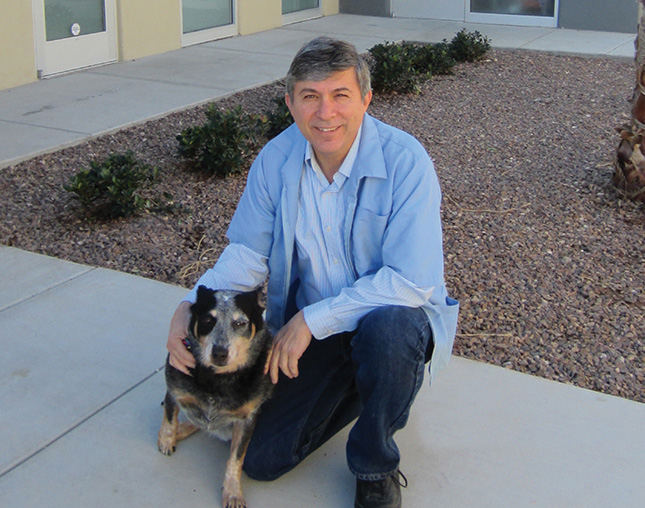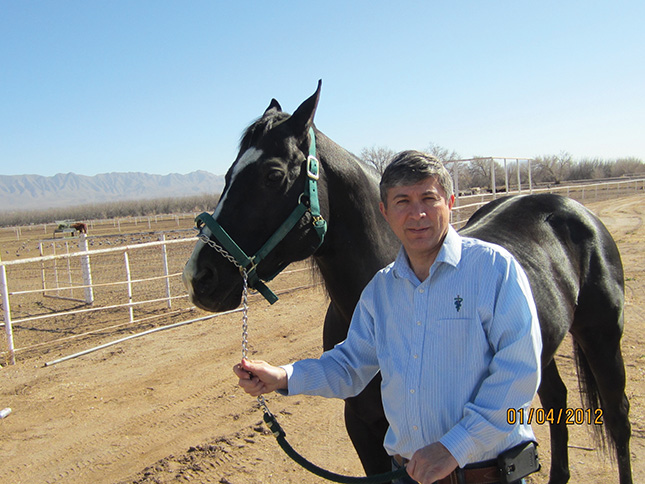Paying it Forward: Dr. Orlando Garza ’79, DVM ’82

One of Dr. Orlando Garza’s greatest career rewards is knowing how far he’s come: he started his practice in 1986 when he converted an empty laundromat into a veterinary clinic. His one employee at the time worked as both secretary and veterinary assistant-and both Garza and his employee cleaned the kennels.
Garza recently opened a new veterinary clinic and hospital in El Paso, Texas. With a glittering two-story glass front and a warm interior with stone accents and tiled floors, the new building is quite impressive. Now he employs 25 staff members and five veterinarians in his new facility. “To see your practice blossom, to see what you’ve created,” he said, “is extremely rewarding.”
Growing up in east El Paso, Garza had many pets: dogs, cats, reptiles, and some exotic animals, but he didn’t consider becoming a veterinarian until he began spending time with his father after school while helping to care for his father’s racehorses. By his freshman or sophomore year in high school, Garza knew that he wanted to be a veterinarian. He earned his bachelor’s degree in biomedical sciences and veterinary science at Texas A&M; University, and then applied to the Texas A&M; College of Veterinary Medicine & Biomedical Sciences (CVM).
However, Garza wasn’t offered an interview when he first applied to veterinary school. More than forty years later, Garza still vividly remembers sitting in his undergraduate genetics class when he opened the rejection letter. With tears streaming down his face, Garza thought to himself, “They will never say ‘no’ to me again.” He increased his GRE scores, applied again, and was accepted into the program. “If it’s really in your heart, you’ll take that ‘no’ as a challenge and do what you need to get it done,” he said.
After graduating with his Doctor of Veterinary Medicine (DVM) degree in 1982, Garza began his veterinary career in Hobbs, New Mexico, in a practice that predominantly treated small animals. Although he enjoyed his work and was grateful for the experience, he always knew that he wished to return to El Paso. “El Paso is just home,” he said. “My family lives here.” After one year in New Mexico, Garza returned to El Paso to work as an associate in a mixed practice that emphasized dairy work. While he enjoyed working with cows, he still wanted to maintain practice with small animals. Garza worked evenings in an emergency care center so that he could “practice [small animal medicine] on a daily basis, hitting veins and performing surgeries. If you don’t use it, you lose it.”
In El Paso, Garza planned to begin his own practice. Luckily, his mother and son found the perfect location for his clinic. While visiting Dairy Queen for ice cream treats called blizzards, they spotted an empty laundromat. Garza bought the building and converted the interior into a veterinary clinic. For the first two years, Garza had one employee; he later hired a veterinary technician. He also continued to renovate his clinic, adding to the building until it reached 3000 square feet. Two years ago, he had the building torn down to make room for his new practice. He and his staff worked out of a doublewide trailer during construction. The new facility is 5000 square feet. “This is a veterinary clinic and hospital,” Garza said, “the previous place was a building that had been converted into a clinic-there’s a big, big, difference.”
Garza’s greatest challenge now that he owns his own clinic and hospital is staff management. When hiring a veterinarian, Garza looks for hardworking individuals who are also gifted communicators. “You can be the world’s best doctor, but if you don’t communicate, it doesn’t matter,” he said. “I think the biggest problem with clients who aren’t satisfied is just lack of communication.” But strong communication doesn’t end at the clinic door: Garza has called clients within 48 hours after a visit to check up on a patient. Often, clients are pleasantly surprised by this considerate action and thank Garza, telling him, “Thank you so much for calling. My own physician would never do that.”
What’s most important to remember when communicating with a client? Smile. “No matter how bad your day was,” Garza recommends, “when you walk into that exam room, have the biggest smile on your face that you possibly can.” Although clients may be concerned and worried for their pets, seeing a big smile instantly breaks the ice and fosters trust.
Another aspect of strong communication is being able to speak in the client’s native language. Practicing in El Paso, Garza finds being bilingual tremendously useful, especially because he is the only veterinarian in his clinic who speaks Spanish. While speaking Spanish isn’t critical, he says, it’s certainly a big help: “If Hispanic clients can speak to you in their native tongue, they automatically trust you more, just because they can communicate with you.”
As a Hispanic veterinarian in Texas, Garza is in a significant minority: of the 5,728 practicing veterinarians in this state, only 84 are Hispanic as of 2010, according to the Texas Tribune. Diversity in the profession is important, Garza says, because the profession should mirror the demographics of its clients. However, medical-minded minority students tend to favor human medicine rather than veterinary medicine-possibly because of a lack of Hispanic role models to promote the profession. As more Hispanics become veterinarians, Garza says, perhaps more students will choose to pursue veterinary medicine.

However, not all Hispanic students choose human medicine because of a lack of role models. One of Garza’s two daughters recently started her pediatric residency in Charleston, South Carolina. But Garza’s not disappointed, even though her career choice is an ongoing joke in the family. “If you’re going to work with little animals who don’t want to talk to you,” Garza told her, “then you should have become a veterinarian instead of a pediatrician.”
For Garza, who previously served as president of the Texas Veterinary Medical Association, service is a key component of the veterinary profession. “We live as individuals but when we speak as a community, we have a lot more power-whether at a local, state, or national level,” he said. He also encourages his employees to give back to the profession and is proud that one of his associates is now president of the El Paso Veterinary Medical Association.
Garza also gives back to his profession by mentoring the next generation of veterinarians. “I’m at a point right now in my life where it’s about paying it forward,” he said. He enjoys giving students opportunities to engage in veterinary work in his practice. “In spite of all that success that I’ve personally had, seeing these young adults work for me, having me guide them a bit, then seeing them get into professional school-for me, that’s amazing.”


